

Compact Muon Solenoid
LHC, CERN
| CMS-BPH-13-008 ; CERN-EP-2017-244 | ||
| Measurement of b hadron lifetimes in pp collisions at $\sqrt{s} = $ 8 TeV | ||
| CMS Collaboration | ||
| 24 October 2017 | ||
| Eur. Phys. J. C 78 (2018) 457 [Erratum] | ||
| Abstract: Measurements are presented of the lifetimes of the $ \mathrm{B}^{0} $, $ \mathrm{B}^{0}_{\mathrm{s}} $, $\Lambda_\mathrm{b}^0$, and $ \mathrm{B}_{\mathrm{c}}^{+} $ hadrons using the decay channels ${\mathrm{B}^{0} \!\to\! \mathrm{J}/\psi {\mathrm{K^{*}(892)}}^{0}}$, ${\mathrm{B}^{0} \!\to\! \mathrm{J}/\psi {\mathrm{K^0_S}}}$, ${\mathrm{B}^{0}_{\mathrm{s}} \!\to\! \mathrm{J}/\psi \pi^{+} \pi^{-}}$, ${\mathrm{B}^{0}_{\mathrm{s}} \!\to\! \mathrm{J}/\psi \phi(1020)}$, $ \Lambda_{\mathrm{b}} \to \mathrm{J}/\psi \Lambda $, and $ \mathrm{B}_{\mathrm{c}}^{+} \to \mathrm{J}/\psi \pi^{+} $. The data sample, corresponding to an integrated luminosity of 19.7 fb$^{-1}$, was collected by the CMS detector at the LHC in proton-proton collisions at $\sqrt{s} = $ 8 TeV. The $ \mathrm{B}^{0} $ lifetime is measured to be 453.0 $\pm$ 1.6 (stat) $\pm$ 1.5 (syst) $\mu$m in ${\mathrm{J}/\psi {\mathrm{K^{*}(892)}}^{0}} $ and 457.8 $\pm$ 2.7 (stat) $\pm$ 2.7 (syst) $\mu$m in ${\mathrm{J}/\psi {\mathrm{K^0_S}}}$, which results in a combined measurement of $c\tau_{\mathrm{B}^{0}} = $ 454.1 $\pm$ 1.4 (stat) $\pm$ 1.3 (syst) $\mu$m. The effective lifetime of the $ \mathrm{B}^{0}_{\mathrm{s}} $ meson is measured in two decay modes, with contributions from different amounts of the heavy and light eigenstates. This results in two different measured lifetimes: $c\tau_{\mathrm{B}^{0}_{\mathrm{s}} \to \mathrm{J}/\psi \pi^{+} \pi^{-}} = $ 502.7 $\pm$ 10.2 (stat) $\pm$ 3.2 (syst) $\mu$m and $c\tau_{\mathrm{B}^{0}_{\mathrm{s}} \to \mathrm{J}/\psi \phi(1020)} = $ 443.9 $\pm$ 2.0 (stat) $\pm$ 1.2 (syst) $\mu$m. The $\Lambda_\mathrm{b}^0$ lifetime is found to be 442.9 $\pm$ 8.2 (stat) $\pm$ 2.7 (syst) $\mu$m. The precision from each of these channels is as good as or better than previous measurements. The $ \mathrm{B}_{\mathrm{c}}^{+} $ lifetime, measured with respect to the $ \mathrm{B^{+}} $ to reduce the systematic uncertainty, is 162.3 $\pm$ 8.2 (stat) $\pm$ 4.7 (syst) $\pm$ 0.1 ($\tau_{\mathrm{B^{+}}}$) $\mu$m. All results are in agreement with current world-average values. | ||
| Links: e-print arXiv:1710.08949 [hep-ex] (PDF) ; CDS record ; inSPIRE record ; HepData record ; CADI line (restricted) ; | ||
| Figures | |

png pdf |
Figure 1:
The combined reconstruction and selection efficiency from simulation versus ${ct}$ with a superimposed fit to an inverse power function for ${\mathrm{B^{+}} \to \mathrm{J}/\psi \mathrm{K^{+}}}$ (upper left), ${\Lambda_{\mathrm{b}}^{0} \to \mathrm{J}/\psi \Lambda ^{0}} $ (upper right), $ {\mathrm{B}^{0} \to \mathrm{J}/\psi {\mathrm{K^0_S}}}$ (centre left), ${\mathrm{B}^{0} \to \mathrm{J}/\psi {\mathrm{K^{*}(892)}} ^{0}} $ (centre right), ${\mathrm{B}^{0}_{\mathrm{s}} \to \mathrm{J}/\psi \pi^{+} \pi^{-}} $ (lower left), and $ {\mathrm{B}^{0}_{\mathrm{s}} \to \mathrm{J}/\psi \phi (1020)} $ (lower right). The efficiency scale is arbitrary. |

png pdf |
Figure 1-a:
The combined reconstruction and selection efficiency from simulation versus ${ct}$ with a superimposed fit to an inverse power function for ${\mathrm{B^{+}} \to \mathrm{J}/\psi \mathrm{K^{+}}}$. The efficiency scale is arbitrary. |
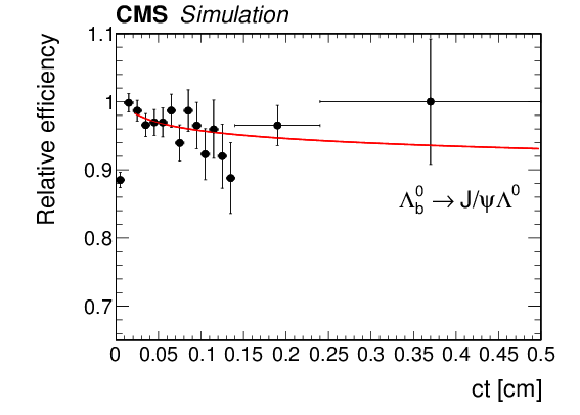
png pdf |
Figure 1-b:
The combined reconstruction and selection efficiency from simulation versus ${ct}$ with a superimposed fit to an inverse power function for ${\Lambda_{\mathrm{b}}^{0} \to \mathrm{J}/\psi \Lambda ^{0}} $. The efficiency scale is arbitrary. |

png pdf |
Figure 1-c:
The combined reconstruction and selection efficiency from simulation versus ${ct}$ with a superimposed fit to an inverse power function for $ {\mathrm{B}^{0} \to \mathrm{J}/\psi {\mathrm{K^0_S}}}$. The efficiency scale is arbitrary. |

png pdf |
Figure 1-d:
The combined reconstruction and selection efficiency from simulation versus ${ct}$ with a superimposed fit to an inverse power function for ${\mathrm{B}^{0} \to \mathrm{J}/\psi {\mathrm{K^{*}(892)}} ^{0}} $. The efficiency scale is arbitrary. |

png pdf |
Figure 1-e:
The combined reconstruction and selection efficiency from simulation versus ${ct}$ with a superimposed fit to an inverse power function for ${\mathrm{B}^{0}_{\mathrm{s}} \to \mathrm{J}/\psi \pi^{+} \pi^{-}} $. The efficiency scale is arbitrary. |

png pdf |
Figure 1-f:
The combined reconstruction and selection efficiency from simulation versus ${ct}$ with a superimposed fit to an inverse power function for $ {\mathrm{B}^{0}_{\mathrm{s}} \to \mathrm{J}/\psi \phi (1020)} $. The efficiency scale is arbitrary. |

png pdf |
Figure 2:
Invariant mass (left) and $ct$ (right) distributions for ${\mathrm{B^{+}}} $ (upper) and for $\Lambda_{\mathrm{b}}^{0}$ (lower) candidates. The curves are projections of the fit to the data, with the contributions from signal (dashed), background (dotted), and the sum of signal and background (solid) shown. The bottom panels of the figures on the right show the difference between the observed data and the fit divided by the data uncertainty. The vertical bars on the data points represent the statistical uncertainties. |

png pdf |
Figure 2-a:
Invariant mass distribution for ${\mathrm{B^{+}}} $ candidates. The curves are projections of the fit to the data, with the contributions from signal (dashed), background (dotted), and the sum of signal and background (solid) shown. The vertical bars on the data points represent the statistical uncertainties. |
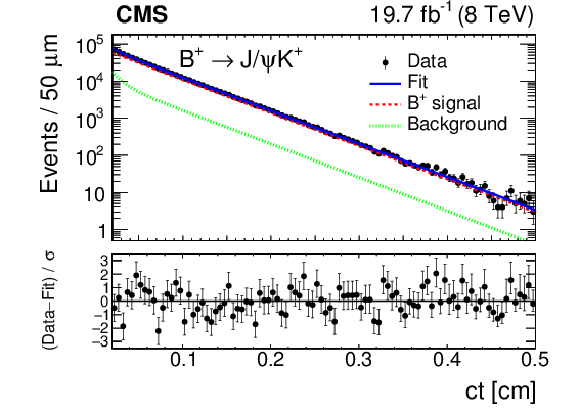
png pdf |
Figure 2-b:
$ct$ distribution for $\Lambda_{\mathrm{b}}^{0}$ candidates. The curves are projections of the fit to the data, with the contributions from signal (dashed), background (dotted), and the sum of signal and background (solid) shown. The bottom panel shows the difference between the observed data and the fit divided by the data uncertainty. The vertical bars on the data points represent the statistical uncertainties. |

png pdf |
Figure 2-c:
Invariant mass distribution for ${\mathrm{B^{+}}} $ candidates. The curves are projections of the fit to the data, with the contributions from signal (dashed), background (dotted), and the sum of signal and background (solid) shown.The vertical bars on the data points represent the statistical uncertainties. |
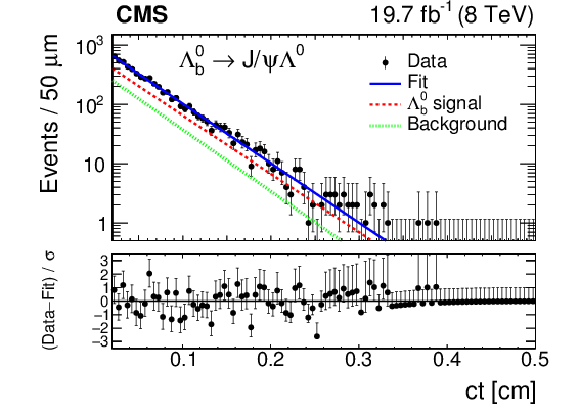
png pdf |
Figure 2-d:
$ct$ distribution for $\Lambda_{\mathrm{b}}^{0}$ candidates. The curves are projections of the fit to the data, with the contributions from signal (dashed), background (dotted), and the sum of signal and background (solid) shown. The bottom panel shows the difference between the observed data and the fit divided by the data uncertainty. The vertical bars on the data points represent the statistical uncertainties. |

png pdf |
Figure 3:
Invariant mass (left) and $ct$ (right) distributions for $ \mathrm{B}^{0} $ candidates reconstructed from $ {\mathrm{J}/\psi {\mathrm{K^{*}(892)}} ^{0}} $ (upper) and $ {\mathrm{J}/\psi {\mathrm{K^0_S}}} $ (lower) decays. The curves are projections of the fit to the data, with the contributions from signal (dashed), background (dotted), and the sum of signal and background (solid) shown. The bottom panels of the figures on the right show the difference between the observed data and the fit divided by the data uncertainty. The vertical bars on the data points represent the statistical uncertainties. |

png pdf |
Figure 3-a:
Invariant mass distribution for $ \mathrm{B}^{0} $ candidates reconstructed from $ {\mathrm{J}/\psi {\mathrm{K^{*}(892)}} ^{0}} $ decays. The curves are projections of the fit to the data, with the contributions from signal (dashed), background (dotted), and the sum of signal and background (solid) shown. The vertical bars on the data points represent the statistical uncertainties. |
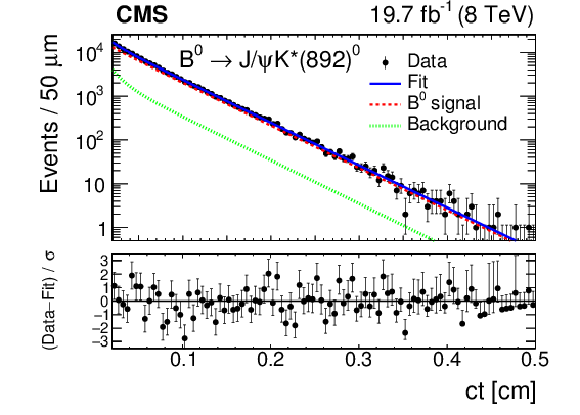
png pdf |
Figure 3-b:
$ct$ distribution for $ \mathrm{B}^{0} $ candidates reconstructed from $ {\mathrm{J}/\psi {\mathrm{K^{*}(892)}} ^{0}} $ decays. The curves are projections of the fit to the data, with the contributions from signal (dashed), background (dotted), and the sum of signal and background (solid) shown. The bottom panel shows the difference between the observed data and the fit divided by the data uncertainty. The vertical bars on the data points represent the statistical uncertainties. |
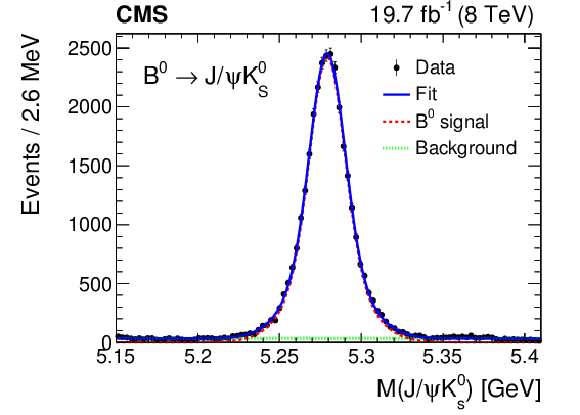
png pdf |
Figure 3-c:
Invariant mass distribution for $ \mathrm{B}^{0} $ candidates reconstructed from $ {\mathrm{J}/\psi {\mathrm{K^0_S}}} $ decays. The curves are projections of the fit to the data, with the contributions from signal (dashed), background (dotted), and the sum of signal and background (solid) shown. The vertical bars on the data points represent the statistical uncertainties. |

png pdf |
Figure 3-d:
$ct$ distribution for $ \mathrm{B}^{0} $ candidates reconstructed from $ {\mathrm{J}/\psi {\mathrm{K^0_S}}} $ decays. The curves are projections of the fit to the data, with the contributions from signal (dashed), background (dotted), and the sum of signal and background (solid) shown. The bottom panel shows the difference between the observed data and the fit divided by the data uncertainty. The vertical bars on the data points represent the statistical uncertainties. |

png pdf |
Figure 4:
Invariant mass (left) and $ct$ (right) distributions for ${ \mathrm{B}^{0}_{\mathrm{s}} }$ candidates reconstructed from ${\mathrm{J}/\psi \phi (1020)}$ (upper) and ${\mathrm{J}/\psi \pi^{+} \pi^{-}}$ (lower) decays. The curves are projections of the fit to the data, with the full fit function (solid) and signal (dashed) shown for both decays, the total background (dotted) shown for the upper plots, and the combinatorial background (dotted), misidentified ${\mathrm{B^{+}} \to \mathrm{J}/\psi \mathrm{K^{+}}}$ background (dashed-dotted), ${\mathrm{B}^{0} \to \mathrm{J}/\psi \pi^{+} \pi^{-}} $ contribution (dashed-dotted-dotted-dotted), and partially reconstructed and other misidentified B backgrounds (dashed-dotted-dotted) shown for the lower plots. The bottom panels of the figures on the right show the difference between the observed data and the fit divided by the data uncertainty. The vertical bars on the data points represent the statistical uncertainties. |

png pdf |
Figure 4-a:
Invariant mass distribution for ${ \mathrm{B}^{0}_{\mathrm{s}} }$ candidates reconstructed from ${\mathrm{J}/\psi \phi (1020)}$ decays. The curves are projections of the fit to the data, with the full fit function (solid) and signal (dashed) shown for both decays, the total background (dotted) shown for the upper plots, and the combinatorial background (dotted), misidentified ${\mathrm{B^{+}} \to \mathrm{J}/\psi \mathrm{K^{+}}}$ background (dashed-dotted), ${\mathrm{B}^{0} \to \mathrm{J}/\psi \pi^{+} \pi^{-}} $ contribution (dashed-dotted-dotted-dotted), and partially reconstructed and other misidentified B backgrounds (dashed-dotted-dotted) shown for the lower plots. The vertical bars on the data points represent the statistical uncertainties. |
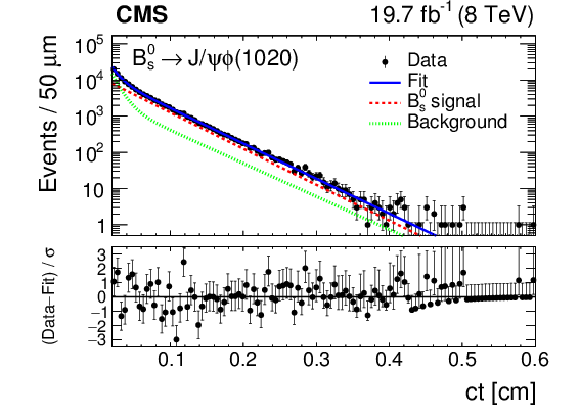
png pdf |
Figure 4-b:
$ct$ distribution for ${ \mathrm{B}^{0}_{\mathrm{s}} }$ candidates reconstructed from ${\mathrm{J}/\psi \phi (1020)}$ decays. The curves are projections of the fit to the data, with the full fit function (solid) and signal (dashed) shown for both decays, the total background (dotted) shown for the upper plots, and the combinatorial background (dotted), misidentified ${\mathrm{B^{+}} \to \mathrm{J}/\psi \mathrm{K^{+}}}$ background (dashed-dotted), ${\mathrm{B}^{0} \to \mathrm{J}/\psi \pi^{+} \pi^{-}} $ contribution (dashed-dotted-dotted-dotted), and partially reconstructed and other misidentified B backgrounds (dashed-dotted-dotted) shown for the lower plots. The bottom panel shows the difference between the observed data and the fit divided by the data uncertainty. The vertical bars on the data points represent the statistical uncertainties. |

png pdf |
Figure 4-c:
Invariant mass distribution for ${ \mathrm{B}^{0}_{\mathrm{s}} }$ candidates reconstructed from ${\mathrm{J}/\psi \pi^{+} \pi^{-}}$ decays. The curves are projections of the fit to the data, with the full fit function (solid) and signal (dashed) shown for both decays, the total background (dotted) shown for the upper plots, and the combinatorial background (dotted), misidentified ${\mathrm{B^{+}} \to \mathrm{J}/\psi \mathrm{K^{+}}}$ background (dashed-dotted), ${\mathrm{B}^{0} \to \mathrm{J}/\psi \pi^{+} \pi^{-}} $ contribution (dashed-dotted-dotted-dotted), and partially reconstructed and other misidentified B backgrounds (dashed-dotted-dotted) shown for the lower plots. The vertical bars on the data points represent the statistical uncertainties. |

png pdf |
Figure 4-d:
$ct$ distribution for ${ \mathrm{B}^{0}_{\mathrm{s}} }$ candidates reconstructed from ${\mathrm{J}/\psi \pi^{+} \pi^{-}}$ decays. The curves are projections of the fit to the data, with the full fit function (solid) and signal (dashed) shown for both decays, the total background (dotted) shown for the upper plots, and the combinatorial background (dotted), misidentified ${\mathrm{B^{+}} \to \mathrm{J}/\psi \mathrm{K^{+}}}$ background (dashed-dotted), ${\mathrm{B}^{0} \to \mathrm{J}/\psi \pi^{+} \pi^{-}} $ contribution (dashed-dotted-dotted-dotted), and partially reconstructed and other misidentified B backgrounds (dashed-dotted-dotted) shown for the lower plots. The bottom panel shows the difference between the observed data and the fit divided by the data uncertainty. The vertical bars on the data points represent the statistical uncertainties. |

png pdf |
Figure 5:
The ${\mathrm{J}/\psi \pi^{+}} $ invariant mass distribution (left) with the solid line representing the total fit, the dashed line the signal component, the dotted line the combinatorial background, and the dashed-dotted line the contribution from $ {\mathrm{B}_{\mathrm{c}}^{+} \to \mathrm{J}/\psi \mathrm{K^{+}}} $ decays. The $ {\mathrm{J}/\psi \mathrm{K^{+}}} $ invariant mass distribution (right) with the solid line representing the total fit, the dashed line the signal component, the dotted-dashed curves the $\mathrm{B^{+}} \to {\mathrm{J}/\psi} \pi^{+} $ and $ \mathrm{B}^{0} $ contributions, and the dotted curve the combinatorial background. The vertical bars on the data points represent the statistical uncertainties. |
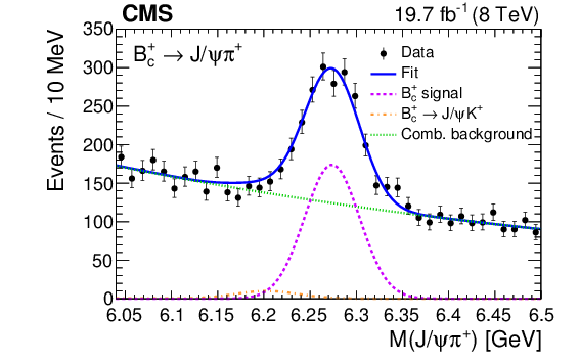
png pdf |
Figure 5-a:
The ${\mathrm{J}/\psi \pi^{+}} $ invariant mass distribution with the solid line representing the total fit, the dashed line the signal component, the dotted line the combinatorial background, and the dashed-dotted line the contribution from $ {\mathrm{B}_{\mathrm{c}}^{+} \to \mathrm{J}/\psi \mathrm{K^{+}}} $ decays. The vertical bars on the data points represent the statistical uncertainties. |

png pdf |
Figure 5-b:
The $ {\mathrm{J}/\psi \mathrm{K^{+}}} $ invariant mass distribution (right) with the solid line representing the total fit, the dashed line the signal component, the dotted-dashed curves the $\mathrm{B^{+}} \to {\mathrm{J}/\psi} \pi^{+} $ and $ \mathrm{B}^{0} $ contributions, and the dotted curve the combinatorial background. The vertical bars on the data points represent the statistical uncertainties. |

png pdf |
Figure 6:
Left: Yields of $ {\mathrm{B}_{\mathrm{c}}^{+} \to \mathrm{J}/\psi \pi^{+}} and {\mathrm{B^{+}} \to \mathrm{J}/\psi \mathrm{K^{+}}} $ events as a function of ${ct}$, normalized to the bin width, as determined from fits to the invariant mass distributions. Right: Ratio of the $ \mathrm{B}_{\mathrm{c}}^{+} $ and $ \mathrm{B^{+}} $ efficiency distributions as a function of ${ct}$, as determined from simulated events. The vertical bars on the data points represent the statistical uncertainties, and the horizontal bars show the bin widths. |

png pdf |
Figure 6-a:
Yields of $ {\mathrm{B}_{\mathrm{c}}^{+} \to \mathrm{J}/\psi \pi^{+}} and {\mathrm{B^{+}} \to \mathrm{J}/\psi \mathrm{K^{+}}} $ events as a function of ${ct}$, normalized to the bin width, as determined from fits to the invariant mass distributions. The vertical bars on the data points represent the statistical uncertainties, and the horizontal bars show the bin widths. |
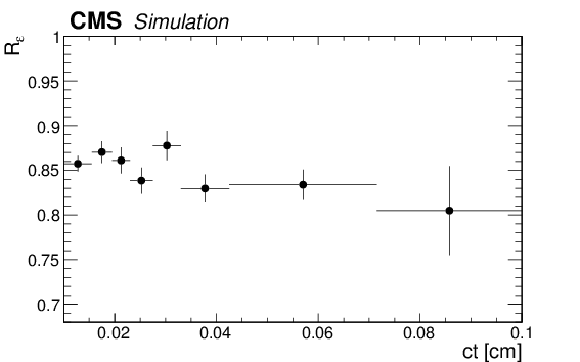
png pdf |
Figure 6-b:
Ratio of the $ \mathrm{B}_{\mathrm{c}}^{+} $ and $ \mathrm{B^{+}} $ efficiency distributions as a function of ${ct}$, as determined from simulated events. The vertical bars on the data points represent the statistical uncertainties, and the horizontal bars show the bin widths. |

png pdf |
Figure 7:
Ratio of the $\mathrm{B}_{\mathrm{c}}^{+} to \mathrm{B^{+}} $ efficiency-corrected ${ct}$ distributions, $R/R_{\varepsilon}$, with a line showing the result of the fit to an exponential function. The vertical bars give the statistical uncertainty in the data, and the horizontal bars show the bin widths. |
| Tables | |

png pdf |
Table 1:
Summary of the sources and values of systematic uncertainties in the lifetime measurements (in $\mu$m). The total systematic uncertainty is the sum in quadrature of the individual uncertainties. |
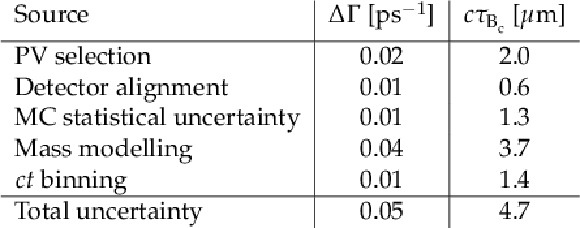
png pdf |
Table 2:
Summary of the systematic uncertainties in the $\Delta \Gamma $ and $c\tau _{\mathrm{B}_{\mathrm{c}}^{+}}$ measurements. |
| Summary |
| The lifetimes of the $ \mathrm{B}^{0} $, $ \mathrm{B}^{0}_{\mathrm{s}} $, $ \Lambda_{\mathrm{b}}^{0} $, and $ \mathrm{B}_{\mathrm{c}}^{+} $ hadrons have been measured using fully reconstructed decays with a $ {\mathrm{J}/\psi} $ meson. The data were collected by the CMS detector in proton-proton collision events at a centre-of-mass energy of 8 TeV, and correspond to an integrated luminosity of 19.7 fb$^{-1}$. The $ \mathrm{B}^{0} $ and $ \mathrm{B}^{0}_{\mathrm{s}} $ meson lifetimes have each been measured in two channels: ${\mathrm{J}/\psi {\mathrm{K^{*}(892)}}^{0}}$, ${\mathrm{J}/\psi {\mathrm{K^0_S}}}$ for $ \mathrm{B}^{0} $ and ${\mathrm{J}/\psi \pi^{+} \pi^{-}}$, ${\mathrm{J}/\psi \phi(1020)}$ for $ \mathrm{B}^{0}_{\mathrm{s}} $. The precision from each channel is as good as or better than previous measurements in the respective channel. The $ \mathrm{B}^{0}_{\mathrm{s}} $ lifetime results are used to obtain the lifetimes of the heavy and light $ \mathrm{B}^{0}_{\mathrm{s}} $ mass eigenstates. The precision of the $ \Lambda_{\mathrm{b}}^{0} $ lifetime measurement is also as good as any previous measurement in the ${\mathrm{J}/\psi \Lambda^{0}}$ channel. The measurement of the $\mathrm{B}_{\mathrm{c}}^{+}$ meson lifetime confirms a longer lifetime than found by the Tevatron experiments, in agreement with results from LHCb. All measured lifetimes are compatible with the current world-average values. |
| References | ||||
| 1 | A. Lenz | Lifetimes and heavy quark expansion | Int. J. Mod. Phys. A 30 (2015) 1543005 | |
| 2 | Particle Data Group, C. Patrignani et al. | Review of particle physics | CPC 40 (2016) 100001 | |
| 3 | CMS Collaboration | The CMS experiment at the CERN LHC | JINST 3 (2008) S08004 | CMS-00-001 |
| 4 | R. Fleischer and R. Knegjens | Effective lifetimes of $ \text{B}_\text{s} $ decays and their constraints on the $ \mathrm{B}^{0}s $--$ {\mathrm{\overline{B}}^0}s $ mixing parameters | EPJC 71 (2011) 1789 | 1109.5115 |
| 5 | LHCb Collaboration | Analysis of the resonant components in $ {\mathrm{\overline{B}}^0}s \to J/\psi \pi^+ \pi^- $ | PRD 86 (2012) 052006 | 1301.5347 |
| 6 | LHCb Collaboration | Measurement of resonant and CP components in $ {\mathrm{\overline{B}}^0}s \to J/\psi \pi^+ \pi^- $ | PRD 89 (2014) 092006 | 1402.6248 |
| 7 | CMS Collaboration | Measurement of the CP-violating weak phase $ \phi_s $ and the decay width difference $ \Delta \Gamma_s $ using the $ \mathrm{B}^{0}s \to J/\psi\phi $(1020) decay channel in pp collisions at $ \sqrt{s}= $ 8 TeV | PLB 757 (2016) 97 | CMS-BPH-13-012 1507.07527 |
| 8 | V. V. Kiselev | Exclusive decays and lifetime of $ \mathrm{B_c} $ meson in QCD sum rules | hep-ph/0211021 | |
| 9 | LHCb Collaboration | Measurement of the $ \mathrm{B}_{\mathrm{c}} $ meson lifetime using $ \mathrm{B}_{\mathrm{c}} \to J\!/\!\psi \mu^+ \nu_{\mu} X $ decays | EPJC 74 (2014) 2839 | 1401.6932 |
| 10 | LHCb Collaboration | Measurement of the lifetime of the $ \mathrm{B}_{\mathrm{c}} $ meson using the $ \mathrm{B}_{\mathrm{c}} \to J/\psi \pi^+ $ decay mode | PLB 742 (2015) 29 | 1411.6899 |
| 11 | CDF Collaboration | Observation of the $ \text{B}_\text{c} $ meson in $ \text{p}\overline{\text{p}} $ collisions at $ \sqrt{s} = $ 1.8 TeV | PRL 81 (1998) 2432 | hep-ex/9805034 |
| 12 | CDF Collaboration | Measurement of the $ \mathrm{B}_{\mathrm{c}} $ meson lifetime using the decay mode $ \mathrm{B}_{\mathrm{c}}\to J/\psi \mathrm{e^{+}} \nu $ | PRL 97 (2006) 012002 | hep-ex/0603027 |
| 13 | D0 Collaboration | Measurement of the lifetime of the $ \text{B}^{\pm}_\text{c} $ meson in the semileptonic decay channel | PRL 102 (2009) 092001 | 0805.2614 |
| 14 | CDF Collaboration | Measurement of the $ \text{B}^-_\text{c} $ meson lifetime in the decay $ \text{B}^-_\text{c} \to J/\psi \pi^- $ | PRD 87 (2013) 011101 | 1210.2366 |
| 15 | CMS Collaboration | Description and performance of track and primary-vertex reconstruction with the CMS tracker | JINST 9 (2014) P10009 | CMS-TRK-11-001 1405.6569 |
| 16 | CMS Collaboration | The CMS trigger system | JINST 12 (2017) P01020 | CMS-TRG-12-001 1609.02366 |
| 17 | T. Sjostrand, S. Mrenna, and P. Z. Skands | PYTHIA 6.4 physics and manual | JHEP 05 (2006) 026 | hep-ph/0603175 |
| 18 | C. Chang, C. Driouchi, P. Eerola, and X. Wu | BCVEGPY: an event generator for hadronic production of the $ \mathrm{B_c} $ meson | CPC 159 (2004) 192 | hep-ph/0309120 |
| 19 | C. Chang, J. Wang, and X. Wu | BCVEGPY2.0: An upgraded version of the generator BCVEGPY with the addition of hadroproduction of the P-wave $ \mathrm{B_c} $ states | CPC 174 (2006) 241 | hep-ph/0504017 |
| 20 | D. J. Lange | The EvtGen particle decay simulation package | NIMA 462 (2001) 152 | |
| 21 | P. Golonka and Z. W\cas | PHOTOS Monte Carlo: a precision tool for QED corrections in Z and W decays | EPJC 45 (2006) 97 | hep-ph/0506026 |
| 22 | GEANT4 Collaboration | GEANT4---a simulation toolkit | NIMA 506 (2003) 250 | |
| 23 | CMS Collaboration | Performance of CMS muon reconstruction in pp collision events at $ \sqrt{s} = $ 7 TeV | JINST 7 (2012) P10002 | CMS-MUO-10-004 1206.4071 |
| 24 | A. S. Dighe, I. Dunietz, and R. Fleischer | Extracting CKM phases and $ \text{B}_\text{s} - \overline{\text{B}}_\text{s} $ mixing parameters from angular distributions of non-leptonic $ \text{B} $ decays | EPJC 6 (1999) 647 | hep-ph/9804253 |
| 25 | LHCb Collaboration | First observation of the decay $ \mathrm{B^+_c}\to \mathrm{J}/\psi \mathrm{K^{+}} $ | JHEP 09 (2013) 075 | 1306.6723 |
| 26 | CMS Collaboration | Alignment of the CMS tracker with LHC and cosmic ray data | JINST 9 (2014) P06009 | CMS-TRK-11-002 1403.2286 |
| 27 | M. J. Oreglia | A study of the reactions $\psi' \to \gamma\gamma \psi$ | PhD thesis, Stanford University, 1980 SLAC Report SLAC-R-236, see Appendix D | |
| 28 | CDF Collaboration | Measurement of branching ratio and $ \mathrm{B}^{0}s $ lifetime in the decay $ \mathrm{B}^{0}s \to J/\psi \text{f}_0(980) $ at CDF | PRD 84 (2011) 052012 | 1106.3682 |
| 29 | LHCb Collaboration | Measurement of CP violation and the $ \mathrm{B}^{0}s $ meson decay width difference with $ \mathrm{B}^{0}s \to J/\psi \mathrm{K^{+}} \mathrm{K^{-}} $ and $ \mathrm{B}^{0}s \to J/\psi \pi^+\pi^- $ decays | PRD 87 (2013) 112010 | 1304.2600 |
| 30 | D0 Collaboration | $ \mathrm{B}^{0}s $ lifetime measurement in the CP-odd decay channel $ \mathrm{B}^{0}s \to J/\psi \text{f}_0(980) $ | PRD 94 (2016) 012001 | 1603.01302 |
| 31 | C.-H. Chang, S.-L. Chen, T.-F. Feng, and X.-Q. Li | Lifetime of the $ \mathrm{B}_{\mathrm{c}} $ meson and some relevant problems | PRD 64 (2001) 014003 | hep-ph/0007162 |
| 32 | M. Beneke and G. Buchalla | $ \mathrm{B}_{\mathrm{c}} $ meson lifetime | PRD 53 (1996) 4991 | hep-ph/9601249 |
| 33 | A. Yu. Anisimov, I. M. Narodetskii, C. Semay, and B. Silvestre-Brac | The $ \mathrm{B}_{\mathrm{c}} $ meson lifetime in the light-front constituent quark model | PLB 452 (1999) 129 | hep-ph/9812514 |
| 34 | V. V. Kiselev, A. E. Kovalsky, and A. K. Likhoded | Decays and lifetime of $ \mathrm{B}_{\mathrm{c}} $ in QCD sum rules | in 5th International Workshop on Heavy Quark Physics, Dubna, Russia, April 6-8 | hep-ph/0006104 |
| 35 | R. Alonso, B. Grinstein, and J. Martin Camalich | Lifetime of $ \mathrm{B}_{\mathrm{c}}^- $ constrains explanations for anomalies in $ \mathrm{B} \to \mathrm{D}^{(*)}\tau\nu $ | PRL 118 (2017) 081802 | 1611.06676 |

|
Compact Muon Solenoid LHC, CERN |

|

|

|

|

|

|